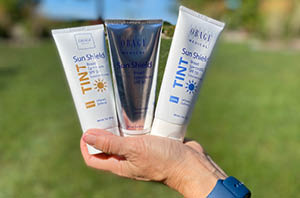Learn how to Protect Your Skin
What is Melanoma?
The cells that produce pigment (color) in the skin are called melanocytes. Melanoma is a type of skin cancer that occurs when the melanocyte cells start growing out of control.
May is Melanoma Month
May is melanoma and skin cancer awareness month. Skin cancer is America’s most common cancer with over five million cases diagnosed annually. During Melanoma Awareness Month it is important to talk about ways to prevent skin cancer like covering the skin when outdoors for long periods of time, using sunscreen, and incorporating a healthy skin care routine.
By educating ourselves and others about healthy skin care routines that include an SPF sunscreen, we can help save lives and prevent melanoma from occurring.
Signs of skin cancer
Changes in moles or coloring of the skin can be a sign of skin cancer. Some of the signs and symptoms to watch out for are:
- Changes in the diameter, texture, and color of the mole
- If the mole has irregular edges
- If the mole or pigmented area is itchy
- If the mole is asymmetrical (if there are two parts to the mole, but they are different sizes and/or shapes)
- The area oozes or bleeds
- There is a change in pigmented skin (darker patches of skin)
- Satellite moles form (smaller moles that grow near a bigger mole)
If you suspect your skin has changed, schedule a skin exam with your medical provider to get checked out. After a thorough exam, you will have a baseline of your skin. Think of it as a map, noting where moles and variations in skin tone occur on your body. Your provider will document any variation on your body. It is a great tool to be able to see if there are any future changes in color, diameter, or thickness of any moles. It will also help you advocate for yourself if you see any future changes in your skin.
It is important to see your provider sooner than later. Suspicious moles are more easily removed when you first notice growth versus waiting for the cells to multiply and spread.
Risk factors
Risk factors are not indicators that you will indeed get skin cancer. They are simply red flags to watch out for. People with these risk factors may be more likely to develop skin cancer.
Risk factors for melanoma include:
- Being fair-skinned. Fair skinned people naturally have less pigment in their skin, so have a higher chance of getting sunburnt, which damages the skin
- Being exposed to sunlight (either natural or artificial such as tanning beds)
- Having had a history of getting blistering sunburns as a child
- Being exposed to certain harmful chemicals in the environment. These could include: solvents, vinyl chloride, radiation, and PCBs (polychlorinated biphenyls, which are industrial chemicals)
- Having a family history of unusual moles
- Having several large moles or many small moles
- Having a family history of melanoma
Being white or having a fair complexion may increase the risk of melanoma, but anyone can get melanoma, including people with darker complexions. Indeed, if you have a darker complexion, you may not notice variations in pigment as early as someone with lighter skin. Please pay close attention to any skin changes you notice.
What you can do to prevent melanoma
1) Wear a good sunscreen. Sunscreen will protect you against harmful UV (ultraviolet) rays. UV rays can damage your skin, which can lead to premature aging, sunburn, and risk of skin cancer. It is recommended to apply sunscreen thoroughly and evenly over areas of the skin that are exposed to the sun. Remember to apply sunscreen to your face, neck, chest, and ears. It is important to reapply sunscreen every two hours, especially if you are swimming or sweating on a hot day.
A good sunscreen with high SPF (sun protection factor) is one of the most effective prevention weapons against melanoma. Also, look for a broad spectrum sunscreen that blocks out both UVA and UVB rays. Sunscreen helps shield the skin against harmful UV rays to protect it from damage.
The American Academy of Dermatology recommends using a sunscreen of 30 SPF or higher. This means it will block out roughly 97% of the UVB rays. Those with lighter skin may want to use an SPF of 50 or above to achieve even more protection.

2) Skin care routine
In addition to applying a high quality sunscreen, a skin care routine is vital for skin health. You should cleanse your skin twice daily, and wear a moisturizer to keep skin hydrated.
Products that contain antioxidants are encouraged because they help protect the skin from free radicals (they occur when electron pairs split up.) Examples of free radicals are dust, smog, cigarette smoke, household cleaners, and pesticides. Free radicals break down the collagen in the skin, which then in turn causes blemishes, saggy skin, wrinkling, and dark spots. Purchase a moisturizer that contains sunscreen as well as antioxidants.

May Special, 20% off sunscreen
3) Join a healthy social media challenge like the #SkinCheckChallenge. Here’s how to participate:
- First, check your skin from head to toe. Look for anything new, changing or unusual.
- Then, post a photo or video of your skin check and share it online with the hashtag #SkinCheckChallenge.
- Share a “thumbs up” photo or tag Skin Cancer Awareness Month us and tell them if you found anything.
- Then, invite two friends to do it too.
Let’s start a skin-checking trend and save lives! The #SkinCheckChallenge is part of an initiative by The Skin Cancer Foundation. https://www.skincancer.org/

4) Wear clothing that covers the skin. When there is high sun exposure, wearing a hat with a rim to protect the face and long sleeves to protect the arms are two ways to protect your skin from over-exposure to harsh UV rays.
“We aren’t seeing any new skin cancer prevention methods. On the contrary, the tried and true prevention techniques we have known for years are what truly work. The facts are if people avoid harmful UV rays, prevent sunburns, and avoid tanning beds, melanoma rates will decrease drastically. The part we are struggling with is convincing individuals to do it,” says Melissa Ravenig, PA-C, Stellis Health Medical Skin Care provider.
Steps to take if you Suspect Melanoma
Schedule an appointment with your provider. Some of the options your provider may discuss with you are:
- Physical exam and medical history
- Skin Exam
- Biopsy
Treatment Options
Treatment options that are available, depending on the severity of and/or the stage of skin cancer:
- Surgery
- Radiation
- Chemotherapy
- Immunotherapy
- Targeted Therapy







